Variation of Runoff and Runoff Components of the Upper Shule River in the Northeastern Qinghai–Tibet Plateau under Climate Change
Abstract
:1. Introduction
2. Data and Methods
2.1. Study Area
2.2. Data Sources
2.3. Estimation of Glacier Thickness
2.4. Description of SPHY Model
2.4.1. Model Principle
2.4.2. Mass Conserving of Glacier
2.4.3. Model Calibration and Validation
3. Results
3.1. Regional Climate Change and Runoff Evolution
3.2. Performance of the SPHY Model
3.3. Glacier Shrinking in the USR
3.4. Annual Variations of Runoff Components
3.5. Monthly Variations of Runoff Components
4. Discussion
4.1. Contributions of Runoff Components to Total Runoff
4.2. Increasing Total Runoff Dominated by Increasing Rainfall
4.3. Uncertainty in the Simulation of Runoff and Runoff Components
5. Conclusions
Author Contributions
Funding
Institutional Review Board Statement
Informed Consent Statement
Data Availability Statement
Acknowledgments
Conflicts of Interest
References
- Li, K.; Chen, R.; Liu, G. Cryosphere water resources simulation and service function evaluation in the Shiyang River Basin of Northwest China. Water 2021, 13, 114. [Google Scholar] [CrossRef]
- Ding, Y.; Ye, B.; Han, T.; Shen, Y.; Liu, S. Regional difference of annual precipitation and discharge variation over west China during the last 50 years. Sci. China Ser. D Earth Sci. 2007, 50, 936–945. [Google Scholar] [CrossRef]
- Yang, Z. Glacier meltwater runoff in China and its nourishment to river. Chin. Geogr. Sci. 1995, 5, 66–76. [Google Scholar] [CrossRef]
- Yang, Z. Mountain stream types in Northwest China. J. Glaciol. Geocryol. 1981, 3, 24–31. [Google Scholar]
- Yang, Z. Glacier water resources of Qilian Mountains. J. Glaciol. Geocryol. 1988, 10, 36–46. [Google Scholar]
- Chen, Y.; Yang, Q.; Luo, Y.; Shen, Y.; Pan, X.; Li, L.; Li, Z. Ponder on the issues of water resources in the arid region of northwest China. Arid. Land Geogr. 2012, 35, 1–9. [Google Scholar]
- Zhang, S.; Ye, B.; Liu, S.; Zhang, X.; Hagemann, S. A modified monthly degree-day model for evaluating glacier runoff changes in China. Part I: Model development. Hydrol. Process. 2012, 26, 1686–1696. [Google Scholar] [CrossRef]
- Piao, S.; Ciais, P.; Huang, Y.; Shen, Z.; Peng, S.; Li, J.; Zhou, L.; Liu, H.; Ma, Y.; Ding, Y.; et al. The impacts of climate change on water resources and agriculture in China. Nature 2010, 467, 43–51. [Google Scholar] [CrossRef] [PubMed]
- Liu, S.; Ding, Y.; Li, J.; Shangguan, D.; Zhang, Y. Glaciers in response to recent climate warming in western China. Quat. Sci. 2006, 26, 762–771. [Google Scholar]
- Cai, X.; Li, Z.; Zhang, H.; Xu, C. Vulnerability of glacier change in the Tianshan Mountains region of China. J. Geogr. Sci. 2021, 31, 1469–1489. [Google Scholar] [CrossRef]
- Duan, J.; Wang, L.; Ren, J.; Li, L. Progress in glacier variations in China and its sensitivity to climatic change during the past century. Prog. Geogr. 2009, 28, 231–237. [Google Scholar]
- Liu, G.; Chen, K.; Li, K. Glacial change and its hydrological response in three inland river basins in the Qilian Mountains, Western China. Water 2021, 13, 2213. [Google Scholar]
- Ding, Y.; Liu, S.; Li, J.; Shangguan, D. The retreat of glaciers in response to recent climate warming in western China. Ann. Glaciol. 2006, 43, 97–105. [Google Scholar] [CrossRef] [Green Version]
- Zhang, X.; Chen, R.; Liu, G.; Yang, Y.; Feng, T. Economic value of freshwater provisioning services of the cryosphere in the Urumqi River, Northwest China. Adv. Clim. Chang. Res. 2021, in press. Available online: https://www.sciencedirect.com/science/article/pii/S1674927821001295 (accessed on 20 November 2021). [CrossRef]
- Ding, Y.; Zhao, Q.; Wu, J.; Zhang, S. The future changes of Chinese cryospheric hydrology and their impacts on water security in arid areas. J. Glaciol. Geocryol. 2020, 42, 23–32. [Google Scholar]
- Sun, M.; Liu, S.; Yao, X.; Guo, W.; Xu, J. Glacier changes in the Qilian Mountains in the past half-century: Based on the revised first and second Chinese glacier inventory. J. Geogr. Sci. 2018, 28, 206–220. [Google Scholar] [CrossRef] [Green Version]
- Wang, H.; Jia, B.; Wang, Y.; Hou, S. Glacier changes in Shulenan Mountain from 1973 to 2018. J. Arid. Land Resour. Environ. 2021, 35, 60–65. [Google Scholar]
- Wang, Y.; Li, J.; Wu, L.; Guo, L.; Li, J. Using remote sensing images to monitor the glacier changes in Qilian Mountains during 1987–2018 and analyzing the impact factors. J. Glaciol. Geocryol. 2020, 42, 344–356. [Google Scholar]
- Shi, Y.; Cao, X.; Wu, J.; Filippo, G.; Dong, W. Simulation of the changes in snow cover over China under global warming by a high resolution RCM. J. Glaciol. Geocryol. 2010, 32, 215–222. [Google Scholar]
- Che, T.; Hao, X.; Dai, L.; Li, H.; Huang, X.; Xiao, L. Snow cover variation and its impacts over the Qinghai-Tibet Plateau. Bull. Chin. Acad. Sci. 2019, 34, 1247–1253. [Google Scholar]
- Liu, X.; Chen, R.; Liu, J.; Wang, X.; Wang, L. Effects of snow-depth change on spring runoff in cryosphere areas of China. Hydrol. Sci. J. 2019, 64, 789–797. [Google Scholar] [CrossRef]
- Ma, R. Characteristics and Causes of Snow Change in Arid Northwest China from 1979 to 2016; Northwest Normal University: Xi’an, China, 2018. [Google Scholar]
- Wang, C.; Zhang, S.; Li, K.; Zhang, F.; Yang, K. Change characteristics of precipitation in Northwest China from 1961 to 2018. Chin. J. Atmos. Sci. 2021, 45, 713–724. [Google Scholar]
- Li, M.; Sun, H.; Su, Z. Research progress in dry/wet climate variation in Northwest China. Geogr. Res. 2021, 40, 1180–1194. [Google Scholar]
- Wang, L.; Chen, R.; Han, C.; Wang, X.; Liu, G.; Song, Y.; Yang, Y.; Liu, J.; Liu, Z.; Liu, X.; et al. Change characteristics of precipitation and temperature in the Qilian Mountains and Hexi Oasis, Northwestern China. Environ. Earth Sci. 2019, 78, 284. [Google Scholar] [CrossRef]
- Li, B.; Chen, Y.; Shi, X.; Chen, Z.; Li, W. Temperature and precipitation changes in different environments in the arid region of northwest China. Theor. Appl. Climatol. 2012, 112, 589–596. [Google Scholar] [CrossRef]
- Wang, C.; Zhang, S.; Zhang, F.; Li, K.; Yang, K. On the increase of precipitation in the Northwestern China under the global warming. Adv. Earth Sci. 2021, 36, 980–989. [Google Scholar]
- Zhang, Q.; Zhu, B.; Yang, J.; Ma, P.; Liu, X.; Lu, G.; Wang, Y.; Yu, H.; Liu, W.; Wang, D. New characteristics about the climate humidification trendin Northwest China. Chin. Sci. Bull. 2021, 66, 3757–3771. [Google Scholar] [CrossRef]
- Ma, S.; Zhou, T.; Dai, A.; Han, Z. Observed changes in the distributions of daily precipitation frequency and amount over China from 1960 to 2013. J. Clim. 2015, 28, 6960–6978. [Google Scholar] [CrossRef]
- Chang, M.; Liu, B.; Martinez-Villalobos, C.; Ren, G.; Li, S.; Zhou, T. Changes in extreme precipitation accumulations during the warm season over Continental China. J. Clim. 2020, 33, 10799–10811. [Google Scholar] [CrossRef]
- Zhang, W.; Zhou, T. Significant increases in extreme precipitation and the associations with global warming over the global land Monsoon regions. J. Clim. 2019, 32, 8465–8488. [Google Scholar] [CrossRef]
- Zhou, B.; Xu, Y.; Wu, J.; Dong, S.; Shi, Y. Changes in temperature and precipitation extreme indices over China: Analysis of a high-resolution grid dataset. Int. J. Climatol. 2016, 36, 1051–1066. [Google Scholar] [CrossRef]
- Chen, R.; Shen, Y.; Mao, W.; Zhang, S.; Lv, H.; Liu, Y.; Liu, Z.; Fang, S.; Zhang, W.; Chen, C.; et al. Progress and issues on key technologies in forecasting of snowmelt flood disaster in arid areas Northwest China. Adv. Earth Sci. 2021, 36, 233–244. [Google Scholar]
- Li, H.; Zhao, Q.; Wu, J.; Ding, Y. Quantitative simulation of the runoff components and its variation characteristics in the upstream of the Shule River. J. Glaciol. Geocryol. 2019, 41, 907–917. [Google Scholar]
- Li, H. Study on the Change of Runoff and Its Components in an Alpine Watershed Based on SPHY Model; University of Chinese Academy of Sciences: Beijing, China, 2019. [Google Scholar]
- Zhou, J. Multi-Methods Study on Runoff Components in Alpine Regions: A Case Study of the Upper Reaches of Shule River Basin; University of Chinese Academy of Sciences: Beijing, China, 2019. [Google Scholar]
- Zhou, J.; Ding, Y.; Wu, J.; Liu, F.; Wang, S. Streamflow generation in semi-arid, glacier-covered, montane catchments in the upper shule river, Qilian Mountains, Northeastern Tibetan Plateau. Hydrol. Process. 2021, 35, e14276. [Google Scholar]
- Wu, J.-K.; Wu, X.-P.; Hou, D.-J.; Liu, S.-W.; Zhang, X.-Y.; Qin, X. Streamwater hydrograph separation in an alpine glacier area in the Qilian Mountains, northwestern China. Int. Assoc. Sci. Hydrol. Bull. 2016, 61, 2399–2410. [Google Scholar] [CrossRef] [Green Version]
- Zhou, J.; Wu, J.; Liu, S.; Zeng, G.; Qin, J.; Wang, X.; Zhao, Q. Hydrograph separation in the headwaters of the Shule river basin: Combining water chemistry and stable isotopes. Adv. Meteorol. 2015, 2015, 830306. [Google Scholar]
- Zhou, J.; Ding, Y.; Wu, J.; Wang, J. Applied comparison analysis of base-flow separation methods in upper Shule River basin. J. Glaciol. Geocryol. 2019, 41, 1456–1466. [Google Scholar]
- Zhang, Z.; Deng, S.; Zhao, Q.; Zhang, S.; Zhang, X. Projected glacier meltwater and river run-off changes in the Upper Reach of the Shule River Basin, north-eastern edge of the Tibetan Plateau. Hydrol. Process. 2019, 33, 1059–1074. [Google Scholar] [CrossRef]
- Zhao, Q.; Ding, Y.; Wang, J.; Gao, H.; Zhang, S.; Zhao, C.; Xu, J.; Han, H.; Shangguan, D. Projecting climate change impacts on hydrological processes on the Tibetan Plateau with model calibration against the glacier inventory data and observed streamflow. J. Hydrol. 2019, 573, 60–81. [Google Scholar] [CrossRef]
- Jin, Z.; Zhao, Q.; Qin, X.; Zhang, J.; Zhang, H.; Qin, J.; Qin, Y.; Li, H.; Chen, J.; Liu, Y.; et al. Quantifying the impact of landscape changes on hydrological variables in the alpine and cold region using hydrological model and remote sensing data. Hydrol. Process. 2021, 35, e14392. [Google Scholar] [CrossRef]
- He, X. Runoff Simulation and Response to Climate Change in the Upper Reaches of the HeiHe River Basin Based on SWAT Model; Northwest Normal University: Lanzhou, China, 2013. [Google Scholar]
- Zhang, G.; Xie, H.; Yao, T.; Li, H.; Duan, S. Quantitative water resources assessment of Qinghai Lake basin using Snowmelt Runoff Model (SRM). J. Hydrol. 2014, 519, 976–987. [Google Scholar] [CrossRef]
- Lutz, A.F.; Immerzeel, W.W.; Shrestha, A.B.; Bierkens, M.F.P. Consistent increase in High Asia’s runoff due to increasing glacier melt and precipitation. Nat. Clim. Chang. 2014, 4, 587–592. [Google Scholar] [CrossRef] [Green Version]
- Terink, W.; Lutz, A.F.; Simons, G.W.H.; Immerzeel, W.W.; Droogers, P. SPHY v2.0: Spatial processes in hydrology. Geosci. Model Dev. 2015, 8, 2009–2034. [Google Scholar] [CrossRef] [Green Version]
- Gao, M. The Analyzing and Simulating of Hydrologic Processes in the Upstream of the Shule River Basin; University of Chinese Academy of Sciences: Beijing, China, 2012. [Google Scholar]
- Liu, S.; Guo, W.; Xu, J. The Second Glacier Inventory Dataset of China (Version 1.0). National Cryosphere Desert Data Center. 2012. Available online: https://data.tpdc.ac.cn/en/data/f92a4346-a33f-497d-9470-2b357ccb4246/ (accessed on 20 November 2021).
- Liu, S.; Yao, X.; Wan, W.; Xu, J.; Shangguan, D.; Wei, J.; Bao, W.; Wu, L. The contemporary glaciers in China based on the Second Chinese Glacier Inventory. Acta Geogr. Sin. 2015, 70, 3–16. [Google Scholar]
- Guo, W.; Liu, S.; Xu, J.; Wu, L.; Shangguan, D.; Yao, X.; Wei, J.; Bao, W.; Yu, P.; Liu, Q.; et al. The second Chinese glacier inventory: Data, methods and results. J. Glaciol. 2017, 61, 357–372. [Google Scholar] [CrossRef] [Green Version]
- Ling, L.; Chao, L. The Chinese Soil Dataset Based on Harmonized World Soil Database Version (HWSD) (v1.1). National Cryosphere Desert Data Center. 2019. Available online: https://data.tpdc.ac.cn/zh-hans/data/611f7d50-b419-4d14-b4dd-4a944b141175/ (accessed on 20 November 2021).
- Radoux, J.; Bontemps, S.; Defourny, P.; Eric, V.; Lamarche, C.; Frédéric, A.; Mayaux, P.; Martin, B.; Brockmann, C.; Kirches, G.; et al. Consistent Global Land Cover Maps for Climate Modeling Communities: Current Achievements of the ESA’s Land Cover CCI. In Proceedings of the ESA Living Planet Symposium, Edinburgh, UK, 9–13 September 2013. [Google Scholar]
- Ouellet Dallaire, C.; Lehner, B.; Sayre, R.; Thieme, M. A multidisciplinary framework to derive global river reach classifications at high spatial resolution. Environ. Res. Lett. 2018, 14, 024003. [Google Scholar] [CrossRef]
- Li, J.; Wang, Y.; Li, J. Glacier Outlines over the Qilian Mountain Area (1980-2015). National Tibetan Plateau Data Center. 2019. Available online: https://data.tpdc.ac.cn/en/data/890e5ad3-56e4-427b-b4b4-f1b4cfc21b2c/ (accessed on 20 November 2021).
- Frey, H.; Machguth, H.; Huss, M.; Huggel, C.; Bajracharya, S.; Bolch, T.; Kulkarni, A.; Linsbauer, A.; Salzmann, N.; Stoffel, M. Estimating the volume of glaciers in the Himalayan–Karakoram region using different methods. Cryosphere 2014, 8, 2313–2333. [Google Scholar] [CrossRef] [Green Version]
- Zou, X.; Gao, H.; Zhang, Y.; Ma, N.; Wu, J.; Farhan, S.B. Quantifying ice storage in upper Indus river basin using ground-penetrating radar measurements and glacier bed topography model version 2. Hydrol. Process. 2021, 35, e14145. [Google Scholar] [CrossRef]
- Linsbauer, A.; Frey, H.; Haeberli, W.; Machguth, H.; Azam, M.F.; Allen, S. Modelling glacier-bed overdeepenings and possible future lakes for the glaciers in the Himalaya—Karakoram region. Ann. Glaciol. 2016, 57, 119–130. [Google Scholar] [CrossRef] [Green Version]
- Haeberli, W.; Hoelzle, M. Application of inventory data for estimating characteristics of and regional climate-change effects on mountain glaciers: A pilot study with the European Alps. Ann. Glaciol. 1995, 21, 206–212. [Google Scholar] [CrossRef] [Green Version]
- Paterson, W. The Physics of Glaciers, 3rd ed.; Pergamon Press: Oxford, UK, 1994. [Google Scholar]
- Karssenberg, D. The value of environmental modeling languages for building distributed hydrological models. Hydrol. Process. 2002, 16, 2751–2766. [Google Scholar] [CrossRef] [Green Version]
- Karssenberg, D.; Schmitz, O.; Salamon, P.; de Jong, K.; Bierkens, M.F.P. A software framework for construction of process-based stochastic spatio-temporal models nd data assimilation. Environ. Model. Softw. 2010, 25, 489–502. [Google Scholar] [CrossRef] [Green Version]
- Schmitz, O.; Karssenberg, D.; de Jong, K.; Kok, J.-L.; de Jong, S. Map algebra and model algebra for integrated model building. Environ. Model. Softw. 2013, 48, 113–128. [Google Scholar] [CrossRef] [Green Version]
- Liang, X.; Wood, E.F.; Lettenmaier, D.P. Surface soil moisture parameterization of the VIC-2L model: Evaluation and modification. Glob. Planet. Chang. 1996, 13, 195–206. [Google Scholar] [CrossRef]
- Liang, X.; Lettenmaier, D.P.; Wood, E.; Burges, S.J. A simple hydrologically based model of land surface water and energy fluxes for general circulation models. J. Geophys. Res. Atmos. 1994, 99, 14415–14428. [Google Scholar] [CrossRef]
- Terink, W.; Lutz, A.F.; Immerzeel, W.; Nepal, S.; Khanal, S.; Shrestha, A.B. Improvement of the SPHY model glacier module and its application in the Tamakoshi River Basin, Nepal. In Proceedings of the Agu Fall Meeting, San Francisco, CA, USA, 12–16 December 2016. [Google Scholar]
- Santhi, C.; Arnold, J.; Williams, J.R.; Dugas, W.A.; Srinivasan, R.; Hauck, L.M. Validation of the SWAT model on a large river basin with point and nonpoint sources. JAWRA J. Am. Water Resour. Assoc. 2001, 37, 1169–1188. [Google Scholar] [CrossRef]
- Chen, R.; Kang, E.; Ding, Y. Some knowledge on and parameters of China’s alpine hydrology. Adv. Water Sci. 2014, 25, 307–317. [Google Scholar]
- Zhang, Y.; Liu, S.; Ding, Y. Spatial variation of degree-day factors on the observed glaciers in Western China. Acta Geogr. Sin. 2006, 61, 89–98. [Google Scholar] [CrossRef] [Green Version]
- Seibert, J. Estimation of parameter uncertainty in the HBV model. Hydrol. Res. 1997, 28, 247–262. [Google Scholar] [CrossRef]
- Chen, R.; Liu, J.; Kang, E.; Yang, Y.; Han, C.; Liu, Z.; Song, Y.; Qing, W.; Zhu, P. Precipitation measurement intercomparison in the Qilian Mountains, north-eastern Tibetan Plateau. Cryosphere 2015, 9, 1995–2008. [Google Scholar] [CrossRef] [Green Version]
- Wang, L.; Chen, R.; Song, Y.; Yang, Y.; Liu, J.; Han, C.; Liu, Z. Precipitation–altitude relationships on different timescales and at different precipitation magnitudes in the Qilian Mountains. Theor. Appl. Climatol. 2017, 134, 875–884. [Google Scholar] [CrossRef]
- Wang, L. Observation and Experimental Study on the Spatial-Temporal Variation of Precipitation in the Qilian Mountains; University of Chinese Academy of Sciences: Beijing, China, 2020. [Google Scholar]
- Zhang, Y.; Liu, S.; Ding, Y. Observed degree-day factors and their spatial variation on glaciers in western China. Ann. Glaciol. 2017, 43, 301–306. [Google Scholar] [CrossRef] [Green Version]
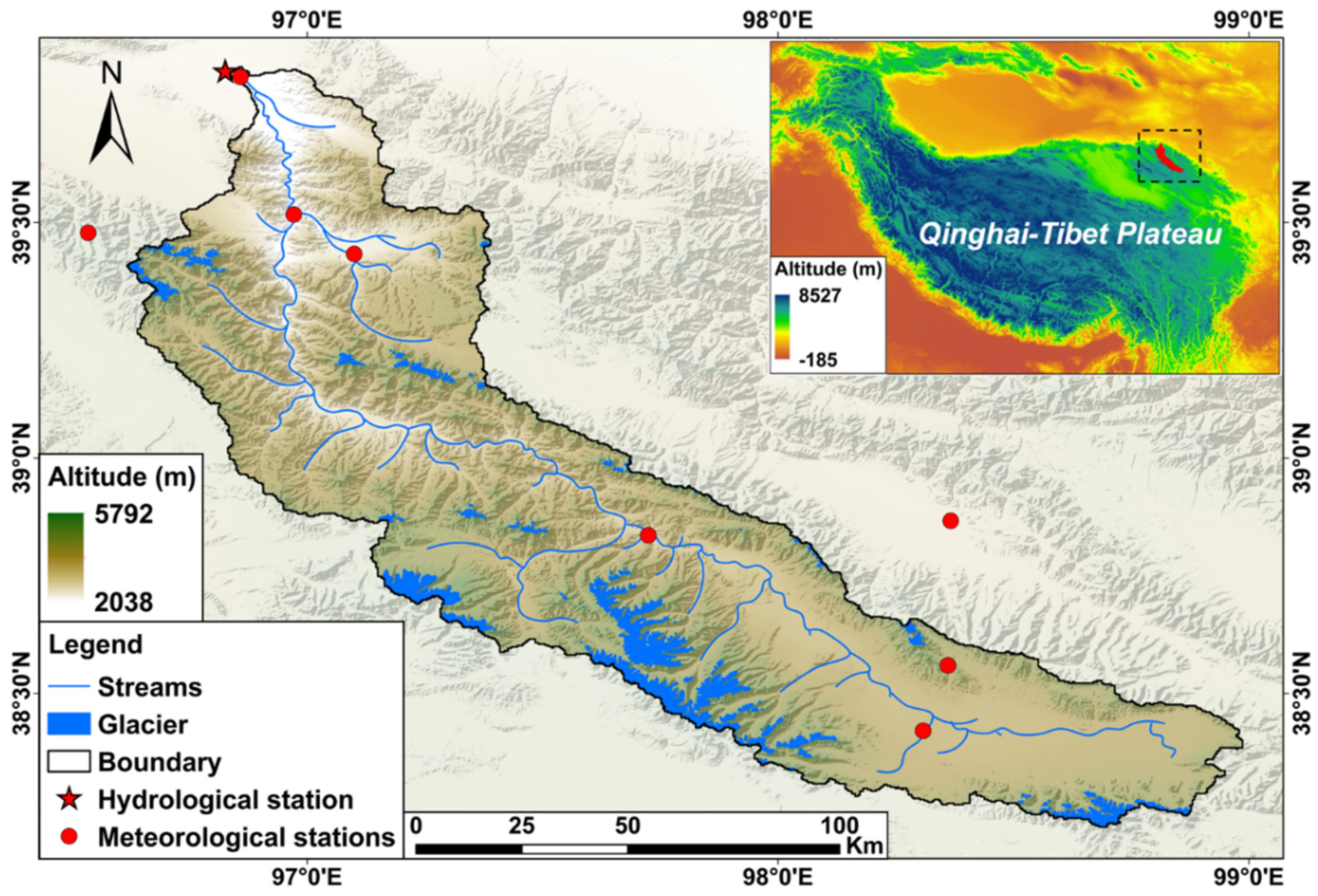
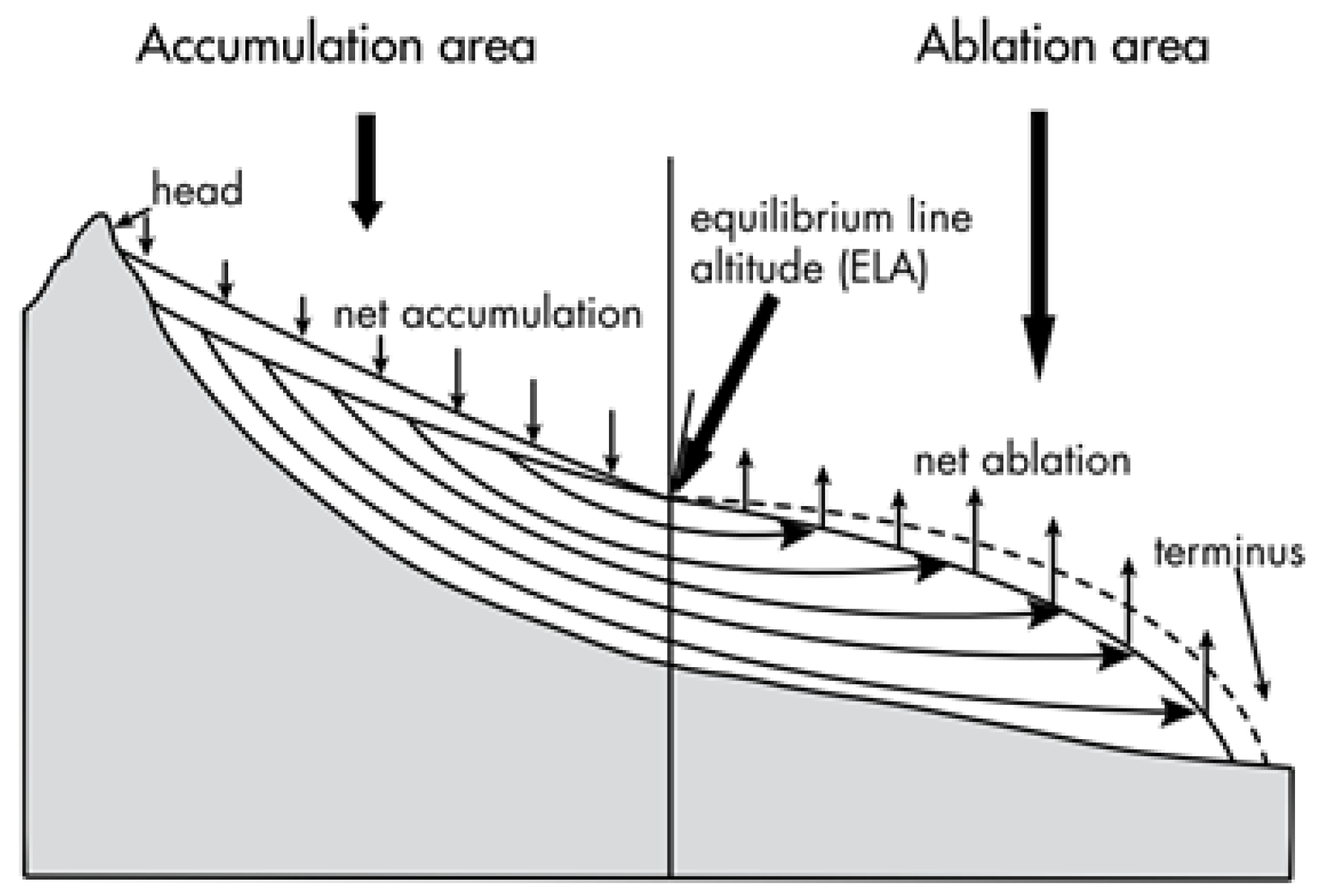
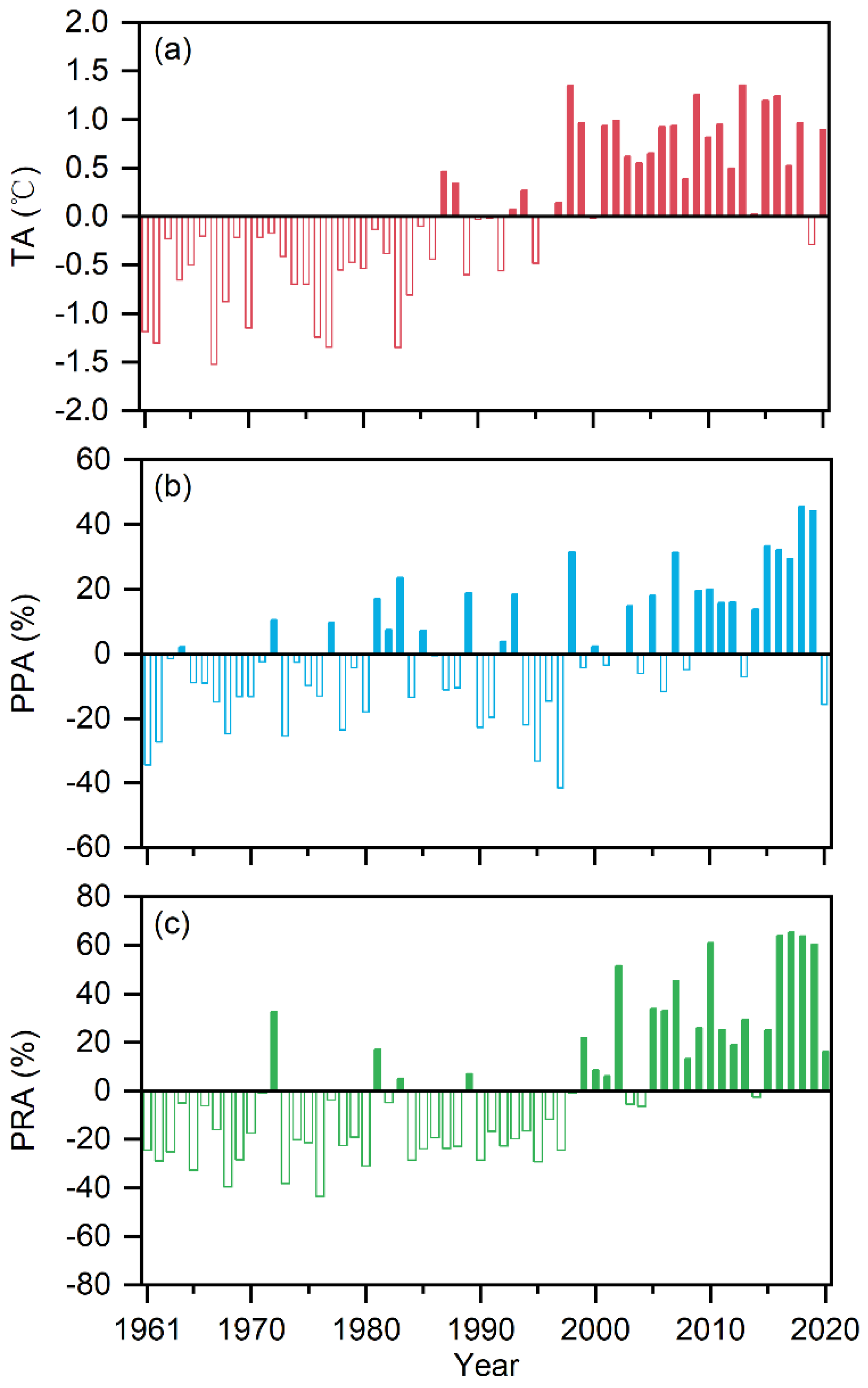
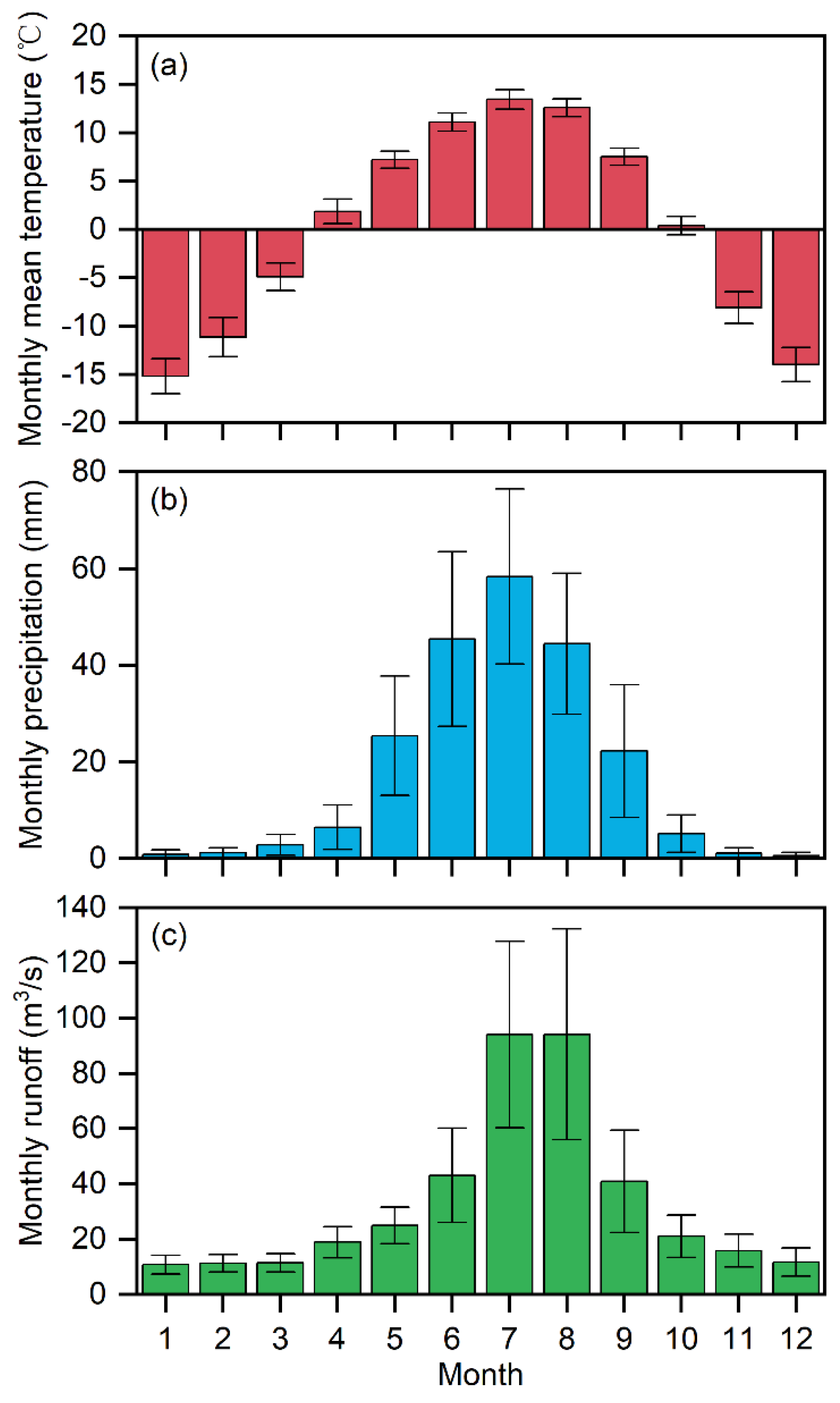

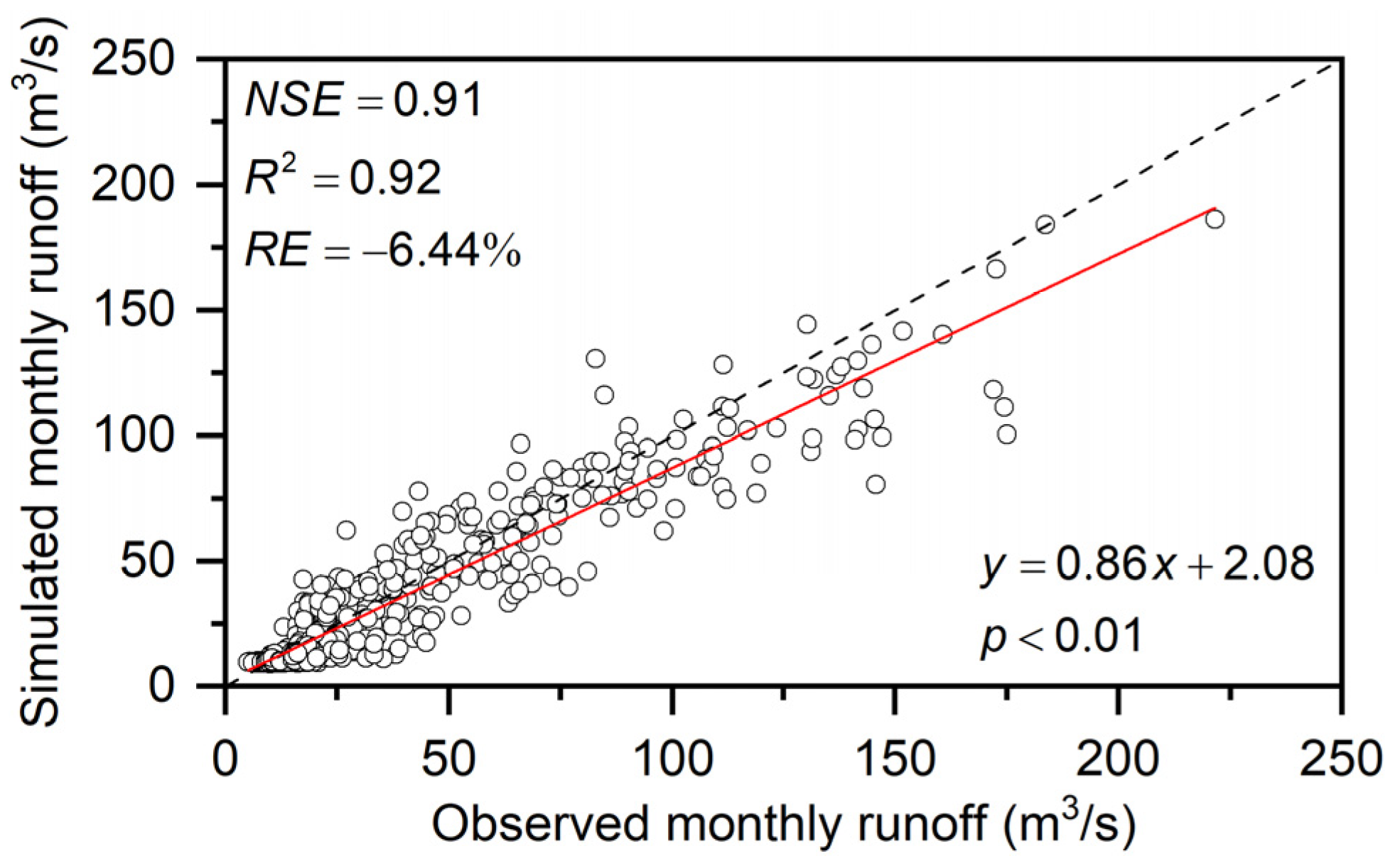


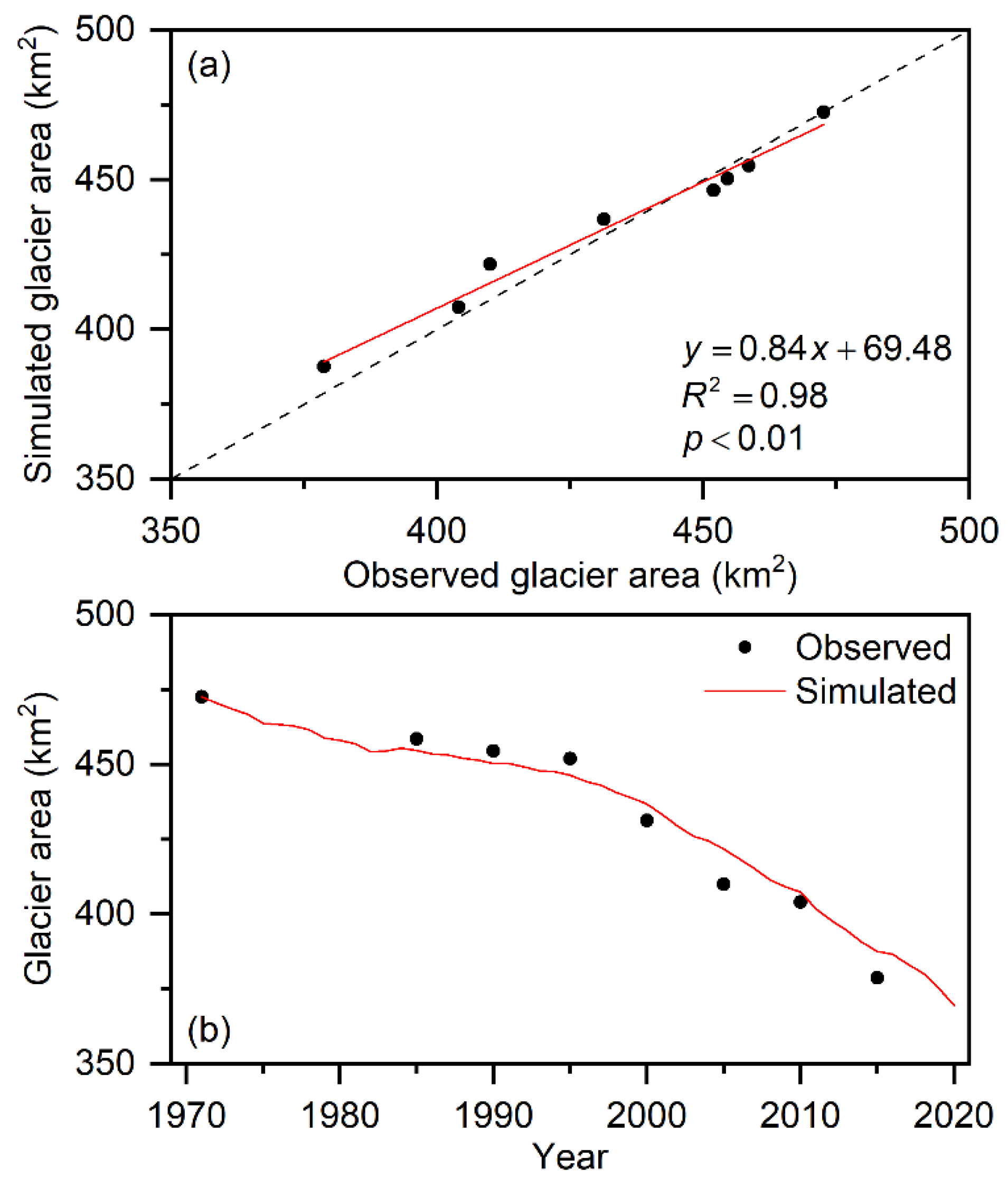


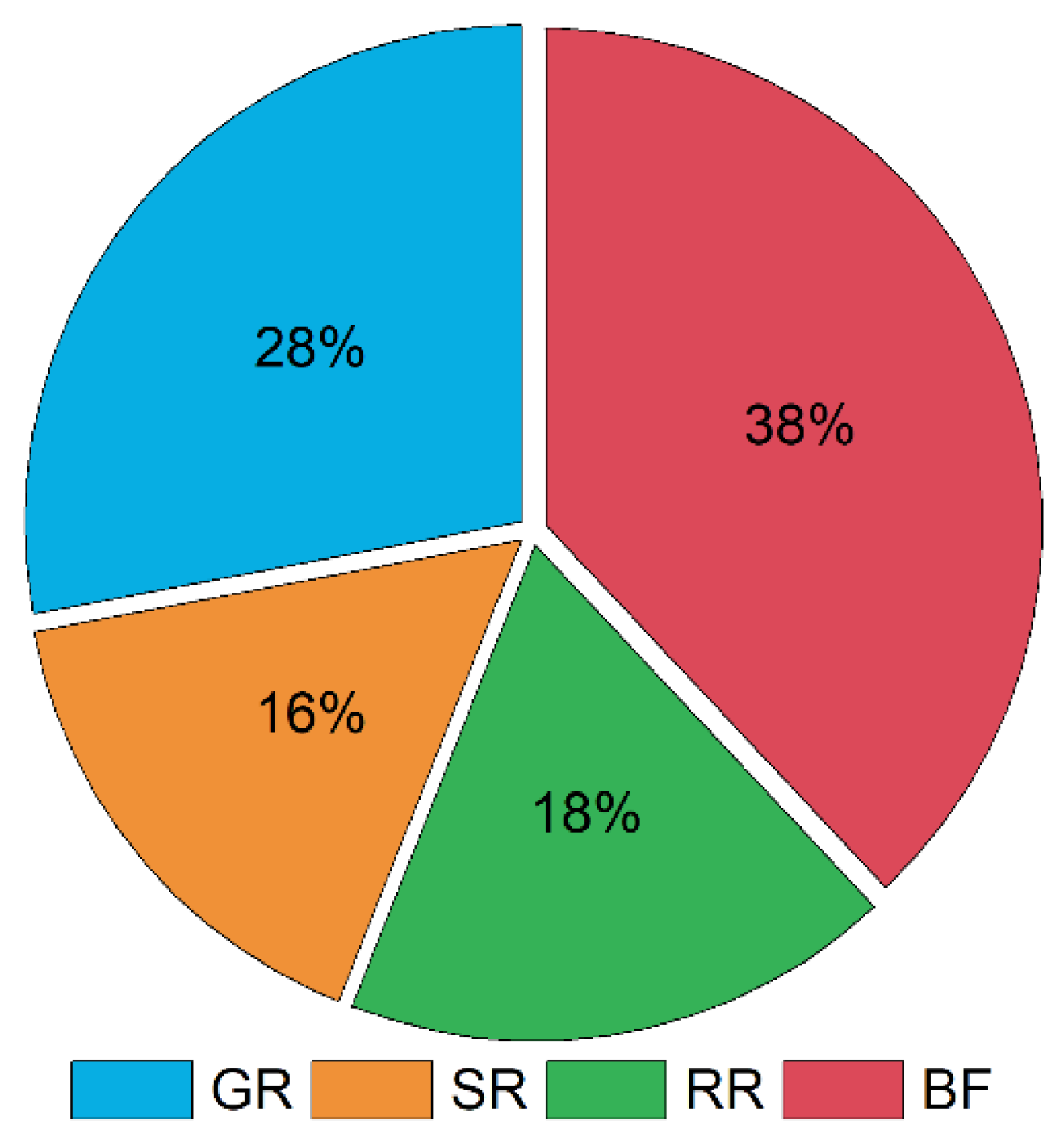
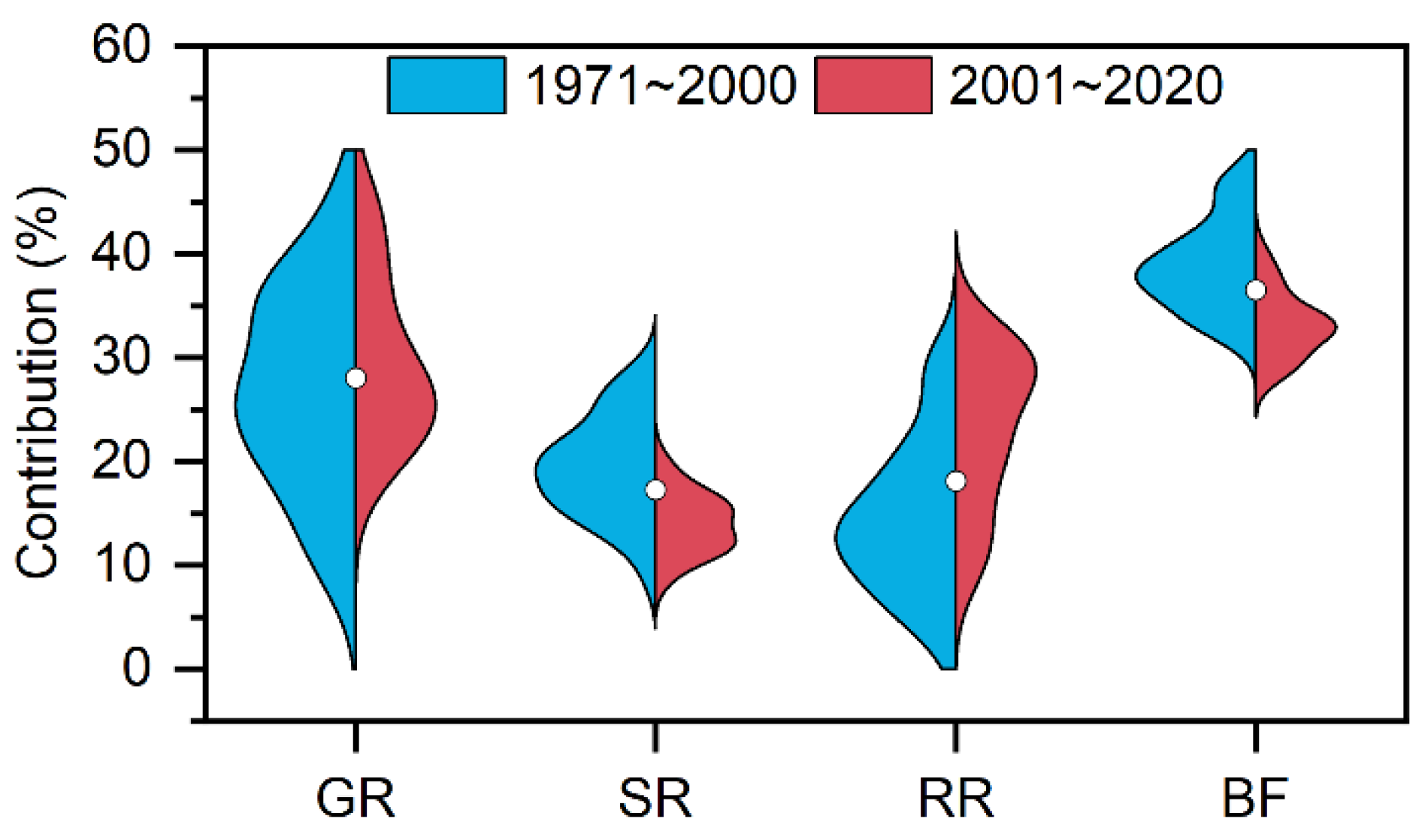
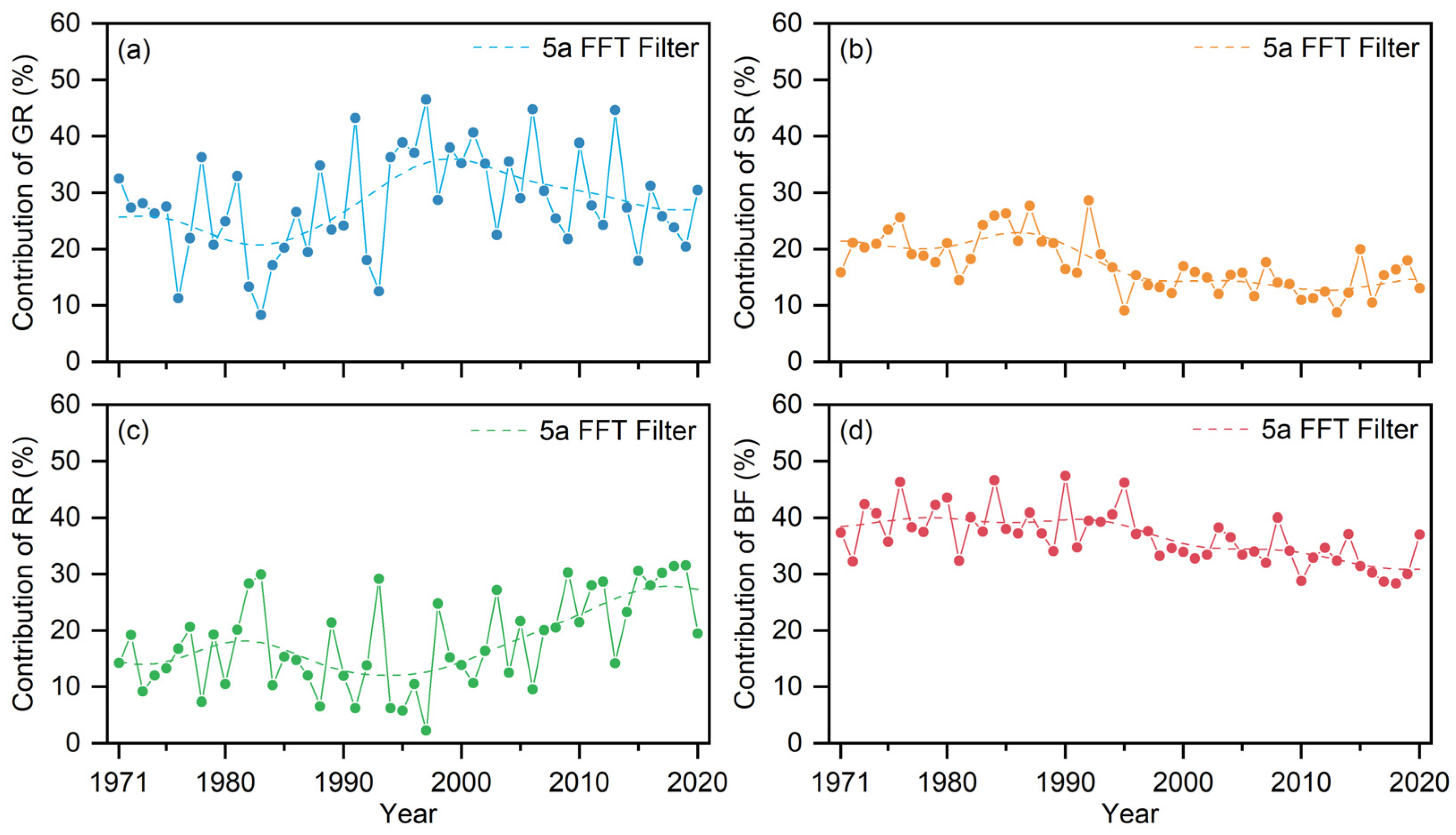
| Station Name | Lat/N | Lon/E | Elevation/m | Data Type | Station Type | Period |
|---|---|---|---|---|---|---|
| CMB | 39°49′ | 96°51′ | 2080 | DR/Prec/Temp | NHS | 2000~2020 |
| YM | 40°16′ | 97°02′ | 1526 | Prec/Temp | NMS | 1961~2020 |
| TL | 38°52′ | 98°22′ | 3360 | Prec/Temp | NMS | 1961~2015 |
| LHG | 39°30′ | 96°30′ | 4180 | Prec/Temp | AWS | 2009~2020 |
| LQZ | 39°31′ | 96°58′ | 2433 | Prec/Temp | AWS | 2009~2020 |
| YEH | 39°26′ | 97°06′ | 2868 | Prec | AWS | 2006~2020 |
| GH | 38°50′ | 97°43′ | 3443 | Prec/Temp | AWS | 2009~2020 |
| SMT | 38°25′ | 98°18′ | 3885 | Prec/Temp | AWS | 2009~2020 |
| MK | 38°34′ | 98°22′ | 4156 | Prec | AWS | 2009~2020 |
| Parameters | Description | Unit | Value | Literatures |
|---|---|---|---|---|
| Root depth | Rootzone soil thickness | mm | 300 | |
| Sub depth | Subzone soil thickness | mm | 1200 | |
| Tcrit | Temperature threshold for precipitation to fall as snow | °C | 0 | [68] |
| DDFS | Degree-day factor for snow | mm/°C/d | 3 | [69] |
| DDFCI | Degree-day factor for debris-free glaciers | mm/°C/d | 6 | [69] |
| δgw | Groundwater recharge delay time | d | 3 | |
| αgw | Baseflow recession factor | - | 0.01 | [70] |
| BFtresh | Threshold for baseflow to occur | mm | 0 | |
| kx | Flow recession coefficient | - | 0.7 |
| Evaluation Indicators | Calibration Period | Validation Period | Simulation Period |
|---|---|---|---|
| NSE | 0.89 | 0.92 | 0.91 |
| R2 | 0.90 | 0.92 | 0.92 |
| RE | −3.82% | −11.51% | −6.44% |
Publisher’s Note: MDPI stays neutral with regard to jurisdictional claims in published maps and institutional affiliations. |
© 2021 by the authors. Licensee MDPI, Basel, Switzerland. This article is an open access article distributed under the terms and conditions of the Creative Commons Attribution (CC BY) license (https://creativecommons.org/licenses/by/4.0/).
Share and Cite
Wu, J.; Li, H.; Zhou, J.; Tai, S.; Wang, X. Variation of Runoff and Runoff Components of the Upper Shule River in the Northeastern Qinghai–Tibet Plateau under Climate Change. Water 2021, 13, 3357. https://doi.org/10.3390/w13233357
Wu J, Li H, Zhou J, Tai S, Wang X. Variation of Runoff and Runoff Components of the Upper Shule River in the Northeastern Qinghai–Tibet Plateau under Climate Change. Water. 2021; 13(23):3357. https://doi.org/10.3390/w13233357
Chicago/Turabian StyleWu, Jinkui, Hongyuan Li, Jiaxin Zhou, Shuya Tai, and Xueliang Wang. 2021. "Variation of Runoff and Runoff Components of the Upper Shule River in the Northeastern Qinghai–Tibet Plateau under Climate Change" Water 13, no. 23: 3357. https://doi.org/10.3390/w13233357






